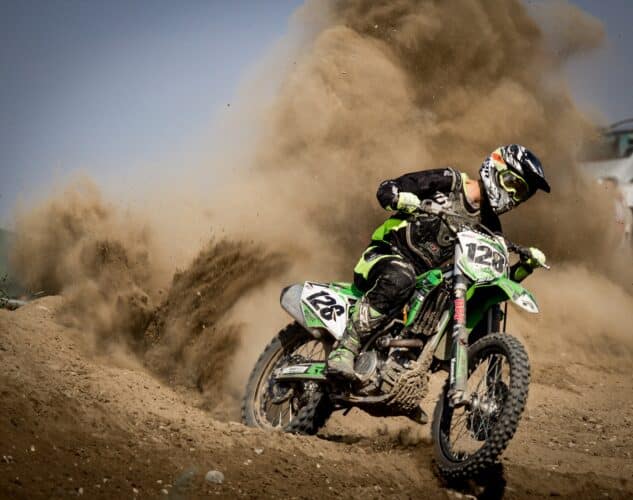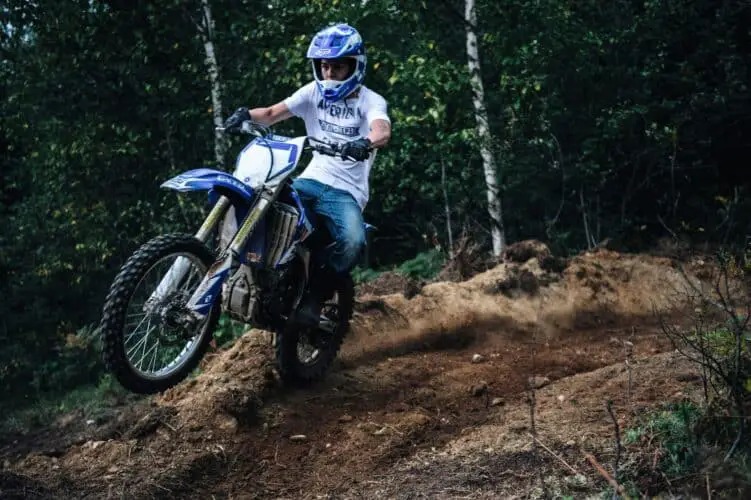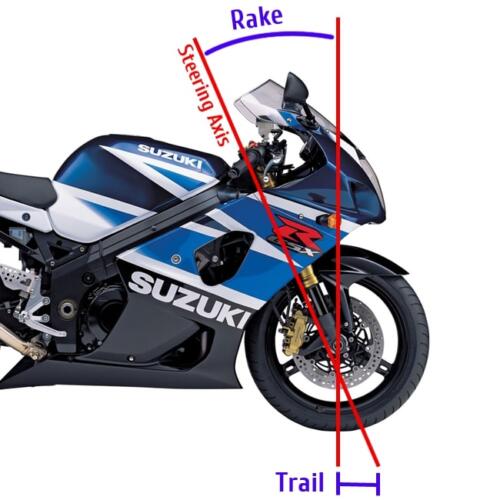When riders read about motorcycle reviews, the two terms that continuously pop up in the discussion are the rake and trail of a motorcycle.
Not just in the reviews, motorcycle dealers often tell the buyers the Rake and Trail numbers on the vehicle that they are about to buy when they are inspecting the machine minutely. So, what is a Rake and a Trail on a Motorcycle?
Rake and Trail refer to the angle of the front part of a motorcycle. This angle not only affects steering and rideability but also can change a rider’s body position. Let’s dive into more details.
What is a Rake on a Motorcycle?

Simply put, the word Rake is an acronym for Angle of Approach and Departure.
This means the Rake angles on a motorcycle are nothing but the angle that the front part of the bike makes with a straight line. To make it more simple, let’s say that every steering head of a bike is connected to the frame of the machine at a particular angle and this angle is called Rake.
Many riders also refer to this angle of connection as Caster. Some also call it the ‘Fork Angle’. It goes without saying that this angle varies from bike to bike – as one goes higher than another.
The rake and trail measurement highlights the angle in degrees for the tire diameter for the front wheel. There are usually editorially chosen rake and trail to support the front wheel and rear wheel for less effort at higher speeds for your motorcycle’s handling. Find out the steering axis, fork offset, steering effort, and motorcycle steering geometry with effective rake and trail calculations.
The Rake of a motorcycle is measured in degrees – it can be anywhere between 20-30 to 45 degrees. The less the vehicle leans forward, the lesser will be its Rake numbers. It increases as this angle goes higher, and henceforth, leaner on your machine means higher the number of the Rake.
It’s also important to understand that there are two types of Rakes – Positive & Negative. If you are buying a bike with positive raking all the measurements are added up together which comes out to be lesser than 180 degrees. But if you have a negative rake, then these measurements will add up to more than 180 degrees.
What Does the Rake Do?

The Rake of a motorcycle affects its stability. A lower Rake means that the bike is more stable, but it may have more rolling on turns.
Also, due to this reason, if you are riding at high speeds then an increased Rake will provide you with good control on the handlebars even when the machine is moving fast.
The rake angle gives an insight into the steering geometry for motorcycles. You get a clear measurement and idea for the front axle, triple clamps, and how to change trail effectively.
On the other hand, an increased Rake can also help with agility and weight distribution at slow speeds or while making sharp curves or twists at low speeds.
Risks Associated with Higher Amounts of Rake
If too much angle (i.e., Rake) is provided in the steering head tube, it’s not only likely to make handling tricky but can prove to be dangerous for the rider.
This is because when you are riding at high speeds, any slight distraction (i.e., anything that makes the bike move) can make it swerve off in an unexpected manner.
This can lead to accidents resulting in serious injuries and even fatalities. A negative rake provides the least amount of stability making it dangerous for road riders who like to go fast on their machines.
What is a Trail on a Motorcycle?
The word Trail means the distance between where your front wheel touches the ground and the point where the steering stem is mounted to your frame of the motorcycle. This line or distance is called ‘Trail’.
For example – if your front wheel’s Ground Clearance is 4 inches, then this number multiplied by 2, will give you the Trail of your machine.
This is because your front wheel touches the ground for 4 inches and then there are two more dimensions to it that include – the steering stem length (which is normally 1/4 inch) and the top of the tire which makes up another inch.
Consequently, if you have a Ground Clearance measurement of 4 inches, then Trail figures out to be 5 inches.
Riding with this kind of number involves high stability but at the same time reduces agility as well as makes controls heavy. It also gives you stability at speeds under 40 mph but tends to become unstable very quickly when the speed crosses that mark.
What Does the Trail Do?
As far as motorcycle reviews are concerned, the Trail is an important measure that helps riders determine the kind of handling their machine will have. It affects how your machine reacts to steering input – both at low speeds as well as at high speeds. The more the Trail, the lesser you’ll need to steer.
Also, it’s not necessary that a bike with greater Trail has better handling, because sometimes manufacturers also increase this figure purely for osmetic purposes.
Another thing that can happen is that larger tire diameters affect your Ground Clearance measurements, causing Machine Roll and making them less maneuverable on hilly terrain or unstable road conditions.
For example – if you are riding on roads that are covered with broken tarmac or ones where there are holes all over because of construction work – then the higher Trail value will make it harder for your motorcycle to lean into the turns.
If you have a low Trail number, then you can move your front tire quickly and easily with less risk of falling or tipping over. This also makes it easier to stop as well as take off from a standstill position.
Understanding the Rake and the Trail Numbers
What both Rake and Trail do is that they affect the Machine Roll of your motorcycle.
If you have a low Trail number, then there will be fewer Machine Roll. If it’s high, then the roll will increase in size making handling challenging for the rider.
The Rake also plays a very important role when it comes to affecting how much Machine Roll takes place on a motorcycle. If this figure is lower in a motorcycle, then again the machine won’t lean as much when turning.
However, riders must keep in mind that while riding at high speeds, having too low Rake figures can make handling difficult because when you want to turn or steer your bike with precision or accuracy, it’s not easy to achieve due to the bike’s high stability.
If you are riding a 150cc scooter at speeds of 70 mph, then your Rake number would be 47 degrees – which is quite low. But if you take it down to around 30 mph, then the same figure will be equal to 75 degrees because, at lower speeds, your motorcycle will lean more when making turns or steering it.
How Does Trail Affect Handling?
The best way to understand how Trail affects handling on motorcycles would be to consider that every inch in this measurement equals about 6 inches when it comes to Machine Roll.
For example – if you have a 4-inch Ground Clearance and 2 inches of extra height added onto that (which is equivalent to 1-inch Trail) your machine will roll over 6 inches. Now compare this to a motorcycle with 4-inch Ground Clearance and no added height (or, you can say zero Trail), then your bike will roll over 12 inches.
While the first figure of 6 inches is quite less and offers great stability at high speeds, it makes turning on highways more challenging because you cannot lean into the turn as much as you would like which means that you need to steer your bike more to make up for that loss. Consequentially, it also becomes difficult to maneuver your machine when faced with emergency maneuvers such as avoiding obstacles while riding at high speeds.
As we saw in the second example where there was zero Trail but still maintained 4-inch Ground Clearance – this offers better handling at high speeds, making it easier to lean into turns and giving the rider more control.
In this example, you can also see that when there is no added height or Trail on a motorcycle then the machine will have greater Ground Clearance and better maneuverability. This means that your bike would be able to manage obstacles like potholes and other road irregularities much better than bikes with higher Trail figures.
What Affects the Rake & the Trail?
There are many factors that affect the Rake and Trail figures of a certain motorcycle.
Since we already know that every inch of extra height (or, instead of that you can say – every inch in increased rake) makes Machine Roll of 6 inches, then let’s see what all things contribute towards affecting this number.
Age
As the age of your motorcycle increases, so does its Fork Angle because fork angles tend to become steeper as bikes grow older.
The Fork Angle is the angle at which the front forks are stuck into the head tube of a motorcycle’s frame.
This angle affects how high or low any motorcycle will sit on the roads during normal riding conditions i.e. when there is no load or passenger that needs to be carried. Some motorcycles have forks that can be adjusted, but that too depends on whether they offer this option for their particular model of bike or not.
Weight & Type
Obviously larger motorcycles with higher weights are likely to create more Machine Roll than smaller motorcycles because larger machines have slower speeds and longer wheelbases as well.
Also, if your motorcycle has a longer wheelbase then it will have lower Rake figures because the distance between the front and rear wheels is greater which causes the front end of a bike with a long wheelbase to tend towards pointing down more easily, creating a steeper Fork Angle.
Plus, different types of motorcycles will have different angles – for example, dirt bikes usually have much higher Rake angles than scooters or any other type of bike.
Road Conditions
Road conditions can also affect Machine Roll on motorcycles with varying degrees depending on what kind of surface you are riding on i.e., whether it is made up of asphalt or concrete or is unpaved terrain such as an off-road trail.
If you are riding at higher speeds then it is more likely that your motorcycle will lean into turns and this increases Machine Roll at the front end apart from just adding extra height to the overall machine.
Rider Weight
The weight of your body when you are riding also affects how much Machine Roll you might be creating on your particular motorcycle.
For example, if you ride in a neutral position with feet placed firmly on both footpegs then there is no effect on the Rake. But if you sit perched up high with your body leaning forward so that it adds 10 pounds per inch to your total height (as compared to when you were sitting upright) then the increased weight contributes towards Machine Roll which means that there would be 6 inches of a roll added onto whatever Ground Clearance figure your motorcycle has.
Hence, it is advisable to sit at a balanced position with your weight slightly forward and not leaning too much towards the handlebar so as to give you better Machine Roll control.
The best way to find out whether Rake and Trail affect how well your bike handles under different conditions is by seeking expert advice from your motorcycle dealer or mechanic who can take all these factors into consideration and then show you specific numbers across different motorcycles that would determine which one will be the most suitable for you, depending on what kind of riding style you follow or intend to employ on your bike.
Conclusion
The Machine Roll on a motorcycle is affected by many different factors, but the most influential ones are Fork Angle, Ground Clearance, Age, Weight, Type, and Road Conditions.
However, it is also important to remember that you should not let these numbers affect your buying decision too much because there are riders who seem to do just fine with Rake and Trail figures that would classify their motorcycle as being “too steep” or “not steep enough”.
Ultimately it all depends upon your riding style whether you lean towards carving corners at speed or prefer sticking to straight lines instead. So if you want more information about how much rake angle will affect your learning abilities then consider seeking advice from experts before making any final decisions about which kinds of motorcycles are best for your particular style of riding.
Happy Riding!







